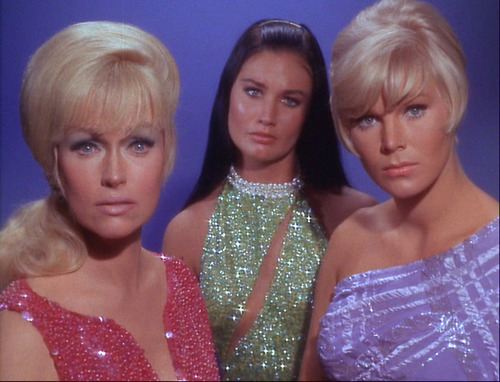I’ve been digging into feminist academic analysis of Star Trek and there is so much fascinating stuff out there. In “Space and the single girl: Star Trek, aesthetics, and 1960s femininity,” Patricia Vettel-Becker looks at how the representation of women in TOS connects to the time it was produced.
Mudd’s Women’ affirmed 1950s-style domesticity as it soothed anxiety over women’s greater participation in public life and increasing sexual frustration in the present and over any threat space colonization might pose to the nuclear family in the future. This episode is thus an example of reactionary storytelling within an overall framework that promotes greater autonomy for women.
To its credit, however, it does at least raise issues that contemporary women were struggling to resolve within their own lives – what roles physical beauty and domesticity should play within a construction of feminine identity and the fear of loneliness if one does not marry, whether by choice or because a suitable mate cannot be found.
Unsurprisingly the Romulan Commander from “The Enterprise Incident” fares a bit better in Vettel-Becker’s analysis:
This Romulan commander, whose name we never learn, is one of the most complex female characters to appear in Star Trek [TOS]. Although powerful women figure prominently in many of the alien civilizations encountered, they are rarely military leaders, let alone commanders.
Moreover, despite being Romulan, she acts very human. Indeed, the Romulan crew is much like that on the Enterprise, which would make her the female equivalent of Captain Kirk. For female viewers she would thus be a fantasy projection, a surrogate, a way for them to imagine themselves in such a position – commanding a starship and its crew while enjoying the pleasures of fashionable attire, comfortable furnishings, and sexual companionship on one’s own terms.
Of course contemporary gender ideologies are still in play, such as the distinction made between being a soldier and a woman, as if one could not be both at the same time.
Citation: “Space and the single girl: Star Trek, aesthetics, and 1960s femininity” by Patricia Vettel-Becker in Frontiers: A Journal of Women’s Studies, 35.2 (May 2014).









